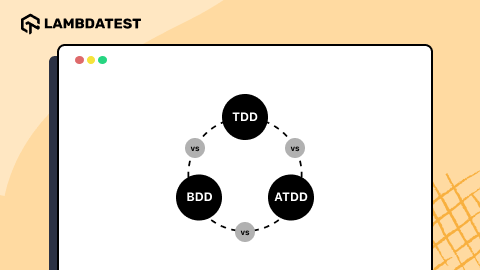Why You Need To Understand Test Management Strategy To Become Pro?
Arnab Roy Chowdhury
Posted On: December 19, 2018
![]() 26622 Views
26622 Views
![]() 7 Min Read
7 Min Read
In the current age, the traditional waterfall model is slowly becoming obsolete, paving the way for Agile and DevOps. Previously, the testing phase was kept to be executed in the end and often when the deadline came closer, testing was done in a hurry, leaving many critical bugs in the open stage. This resulted in a buggy application that required frequent maintenance, missed certain critical business requirements and resulted in the user’s discomfort.
However, in the current Agile age, testers, stakeholders and developers work hand in hand, ensuring that every user story delivered fully satisfies the business requirements. Also, testing is divided into multiple phases such as accessibility testing, cross browser testing, performance testing, usability testing, regression testing and many more. Priority is not on the delivery of the product, but the delivery of a flawless product.
However, speed is the one thing which is prioritized by customers worldwide. It is necessary that an effective test management strategy is followed to fast-track testing in a flawless manner, resulting in timely delivery of the product. In the following article, we shall discuss why it is must to have a test management strategy in your current project.

Handling Frequent Changes
In the current Agile age, the project is constantly being updated with new enhancements or business requirements. The team may deliver a certain part of the application in one sprint and in the very next, the client may require the same thing in a different manner or a completely new thing based on the same idea. The situation may arise when the test cases were not updated based on the new requirement, resulting in failure of some test cases or some critical business issue signed off. An effective test management strategy is important to ensure that the testing team stays constantly updated about the new changes in requirement and is always ready to write effective test cases for testing those requirements.
For Streamlined Tracking
It is important to check each step of a testing cycle when the progression of a project occurs from one stage to another. For a smooth transition, it is necessary to maintain a track record of each testing phase, and not only with respect to your Production environment, but also to maintain a constant track of the Staging environment. An ideal test management strategy ensures that the progress is recorded in the form of a report or dashboard. This not only benefits the current project but also the future ones since it allows the team to detect any test requirement that is incompatible. An efficient test management strategy helps to document the test cases which can be reused as well.
Tracking of Task Assigned
Another importance of test management strategy is that it helps to assign a particular task to the person whose skill set is appropriate for completion of that task. Effective test management involves usage of tracking tools that ensure whether the task assigned has been performed, the time when it is completed and the person to whom the task was assigned. When individual efforts are combined, this, in turn, helps to keep track of the entire team’s work.
A Scalable Environment
Test management often ensures that the data is stored in a way where it is accessible to all team members. Having an effective test management strategy makes sure that an environment is created which allows easy information exchange regarding the project and knowledge documents among different members of the team. If a test management tool is used, it allows scalable cloud-based data exchange by which the team members can access all the test data and metrics without any complication.
Real Time Project Report
Another importance of test management strategy is that it helps to maintain documentation based on how a product is tested in real time. Real-time reporting also helps to analyze the team or the manager about what is happening on a specific project. Even the development team can get instant response from the quality analysts regarding a certain defect or bug, thereby enabling the project’s flexibility. Having a real-time report helps to speed up the overall QA process by providing continuous feedback about how a product is behaving from either the quality analyst or in case of Agile, from the stakeholders.
Keeping the Test Data Secured
An effective test management strategy ensures that your data is kept safe and secure. If a test management tool is used, it ensures that the team can exchange test data confidentially via SSL drove security procedures being free from the worry of information leakage or data misuse. Security parameters are also involved that ensures that individual team members can only access information meant for them and also the management can track the overall report along with data on individual work progress.
How Test Plan is Different from Test management strategy?
Although both may sound same, there are some significant differences.
- Test plan can be defined as a document stating about the objective, scope, and approach related to the efforts in the testing phase. While test management strategy is more of a guideline that determines how testing should be done.
- Test plan consists of components like a unique ID, testing techniques, features that require testing, criteria for passing and failing of test cases, deliverables, schedule, etc. Test strategy includes scope and objectives, processes and documentation, reporting structure of the team and communication strategy of clients.
- A testing manager executes test plan, deciding on how and when to test along with the task assigned to specific members and task details. Project manager executes a testing strategy along with the techniques to be followed and the modules that require testing.
- Test plan tells the team about the specification and can be changed. Test management strategy is more about the general approaches which remain unchanged.
- A test plan can exist individually at a project level. Test strategies are often found to be a subsection of the test plan and can be used by multiple projects.
- Test plan is of short-term where the objective is to detect dependencies and probable issues. However, test strategy is a long-term plan which may not be specific to any project.
Best Practices For Test Management Strategy
The following best practices should be kept in your checklist to ensure effective test management.
- Testing should begin as early as possible in the software development lifecycle which will ensure more bugs being detected and sufficient time for bug fixing.
- Testing should be executed iteratively that will focus more on bugs and reduce unwanted delays in test completion.
- Automation scripts and assets should be reused as much as possible to reduce time complexity.
- Different testing approaches should be followed to find the one that suits your requirement. One should follow an approach based on the requirement which will help in the application’s validation.
- Resources should work together in a well-coordinated manner which will make sure that knowledge exchange or resource sharing occurs flawlessly, resulting in quick and fast delivery.
- The correct status of a defect should be communicated at the right time which will ensure that it is promptly fixed.
- Utilize automation tools, especially during unit testing to save time and focus on other testing faces that require manual intervention.
Effective test management strategy is very pivotal for developing any hardware as well as a software product. A well planned and well-executed testing procedure ensures that the team is delivering the best product that can satisfy the customer’s requirement. No matter how limited their resources are, they can make the most out of it. Especially with a large team, distributed across various geographic location, a test management strategy is a key to the success of a large project.
Got Questions? Drop them on LambdaTest Community. Visit now












